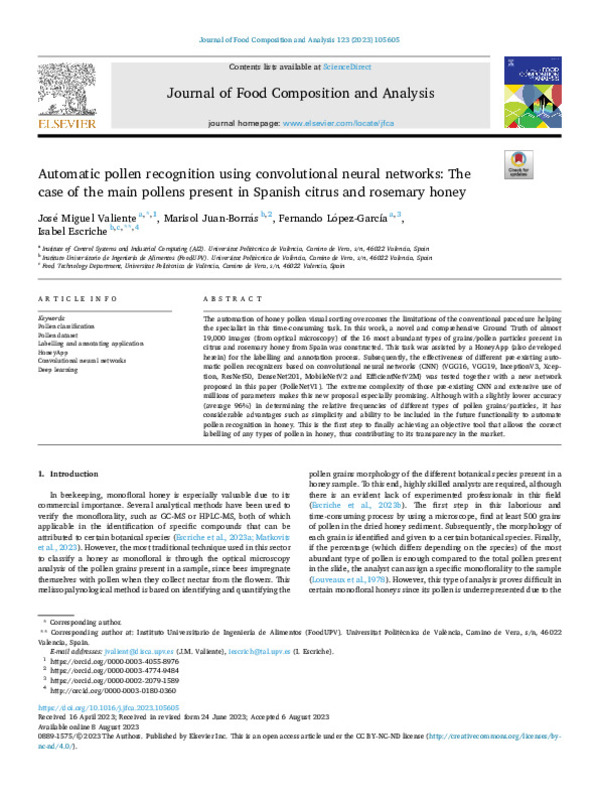JavaScript is disabled for your browser. Some features of this site may not work without it.
Buscar en RiuNet
Listar
Mi cuenta
Estadísticas
Ayuda RiuNet
Admin. UPV
Automatic pollen recognition using convolutional neural networks: The case of the main pollens present in Spanish citrus and rosemary honey
Mostrar el registro sencillo del ítem
Ficheros en el ítem
| dc.contributor.author | Valiente González, José Miguel
|
es_ES |
| dc.contributor.author | Juan-Borras, María del Sol
|
es_ES |
| dc.contributor.author | López García, Fernando
|
es_ES |
| dc.contributor.author | Escriche Roberto, Mª Isabel
|
es_ES |
| dc.date.accessioned | 2024-01-08T19:02:30Z | |
| dc.date.available | 2024-01-08T19:02:30Z | |
| dc.date.issued | 2023-10 | es_ES |
| dc.identifier.issn | 0889-1575 | es_ES |
| dc.identifier.uri | http://hdl.handle.net/10251/201613 | |
| dc.description.abstract | [EN] The automation of honey pollen visual sorting overcomes the limitations of the conventional procedure helping the specialist in this time-consuming task. In this work, a novel and comprehensive Ground Truth of almost 19,000 images (from optical microscopy) of the 16 most abundant types of grains/pollen particles present in citrus and rosemary honey from Spain was constructed. This task was assisted by a HoneyApp (also developed herein) for the labelling and annotation process. Subsequently, the effectiveness of different pre-existing automatic pollen recognizers based on convolutional neural networks (CNN) (VGG16, VGG19, InceptionV3, Xception, ResNet50, DenseNet201, MobileNetV2 and EfficientNetV2M) was tested together with a new network proposed in this paper (PolleNetV1). The extreme complexity of those pre-existing CNN and extensive use of millions of parameters makes this new proposal especially promising. Although with a slightly lower accuracy (average 96%) in determining the relative frequencies of different types of pollen grains/particles, it has considerable advantages such as simplicity and ability to be included in the future functionality to automate pollen recognition in honey. This is the first step to finally achieving an objective tool that allows the correct labelling of any types of pollen in honey, thus contributing to its transparency in the market. | es_ES |
| dc.description.sponsorship | This work is part of Spanish project PID2019-106800RB-I00 (2019) with financial support from the Ministerio de Ciencia e Innovacion (MCIN), Agencia Estatal de Investigacion MCIN/AEI/10.13039/501100011033/. It has been also part of the project AGROALNEXT/2022/043, funded by the Next Generation European Union and the Plan de Recuperacion, Transformacion y Resiliencia of the Spanish Government, with the support of Generalitat Valenciana. The authors would like to thank the CRUE-Universitat Politecnica deValencia for providing the funds for open access publication. | es_ES |
| dc.language | Inglés | es_ES |
| dc.publisher | Elsevier | es_ES |
| dc.relation.ispartof | Journal of Food Composition and Analysis | es_ES |
| dc.rights | Reconocimiento - No comercial - Sin obra derivada (by-nc-nd) | es_ES |
| dc.subject | Pollen classification | es_ES |
| dc.subject | Pollen dataset | es_ES |
| dc.subject | Labelling and annotating application | es_ES |
| dc.subject | HoneyApp | es_ES |
| dc.subject | Convolutional neural networks | es_ES |
| dc.subject | Deep learning | es_ES |
| dc.subject.classification | TECNOLOGIA DE ALIMENTOS | es_ES |
| dc.subject.classification | ARQUITECTURA Y TECNOLOGIA DE COMPUTADORES | es_ES |
| dc.title | Automatic pollen recognition using convolutional neural networks: The case of the main pollens present in Spanish citrus and rosemary honey | es_ES |
| dc.type | Artículo | es_ES |
| dc.identifier.doi | 10.1016/j.jfca.2023.105605 | es_ES |
| dc.relation.projectID | info:eu-repo/grantAgreement/AEI/Plan Estatal de Investigación Científica y Técnica y de Innovación 2017-2020/PID2019-106800RB-I00/ES/ANALISIS POLINICO AUTOMATICO EMPLEANDO REDES NEURONALES CONVOLUCIONALES: APLICACION A LA CLASIFICACION MONOFLORAL DE LA MIEL/ | es_ES |
| dc.relation.projectID | info:eu-repo/grantAgreement/GV INNOV.UNI.CIENCIA//AGROALNEXT%2F2022%2F043//TECNICAS ANALÍTICAS RÁPIDAS PARA EVALUAR SEGURIDAD, ADULTERACION Y TRAZABILIDAD EN PRODUCTOS DE LA COLMENA. APLICACIÓN A UN CULTIVO EN TRANSICIÓN AGROECOLÓGICA/ | es_ES |
| dc.rights.accessRights | Abierto | es_ES |
| dc.contributor.affiliation | Universitat Politècnica de València. Escuela Técnica Superior de Ingeniería Agronómica y del Medio Natural - Escola Tècnica Superior d'Enginyeria Agronòmica i del Medi Natural | es_ES |
| dc.contributor.affiliation | Universitat Politècnica de València. Escola Tècnica Superior d'Enginyeria Informàtica | es_ES |
| dc.description.bibliographicCitation | Valiente González, JM.; Juan-Borras, MDS.; López García, F.; Escriche Roberto, MI. (2023). Automatic pollen recognition using convolutional neural networks: The case of the main pollens present in Spanish citrus and rosemary honey. Journal of Food Composition and Analysis. 123:1-10. https://doi.org/10.1016/j.jfca.2023.105605 | es_ES |
| dc.description.accrualMethod | S | es_ES |
| dc.relation.publisherversion | https://doi.org/10.1016/j.jfca.2023.105605 | es_ES |
| dc.description.upvformatpinicio | 1 | es_ES |
| dc.description.upvformatpfin | 10 | es_ES |
| dc.type.version | info:eu-repo/semantics/publishedVersion | es_ES |
| dc.description.volume | 123 | es_ES |
| dc.relation.pasarela | S\505905 | es_ES |
| dc.contributor.funder | GENERALITAT VALENCIANA | es_ES |
| dc.contributor.funder | AGENCIA ESTATAL DE INVESTIGACION | es_ES |
| dc.contributor.funder | Universitat Politècnica de València | es_ES |








